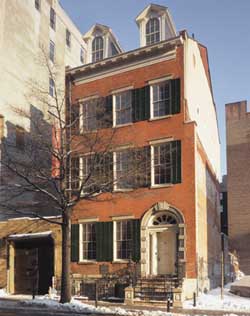How The Tredwell House Became The Merchant’s House Museum
The Merchant’s House Museum at 29 East Fourth Street offers a most comprehensive view into what life might have been like for the wealthy merchant class in New York City during the 19th-century. While the house and its history date to 1832, its life as a museum began more than a century later in 1936 due to a wonderful twist of fate.

In 1832, Joseph Brewster (a hatter by trade, who also speculated in real estate) built a brick and marble row house on Fourth Street in what was then a quiet, exclusive suburb of New York City. In 1835, three years later, Seabury Tredwell purchased the house and lived there with his wife, Eliza, their eight children, and four Irish servants. The family lived in the house continuously for almost 100 years.

When the youngest member of the Tredwell family, Gertrude Treadwell, died in the house in 1933, her niece and heir, Lillie Nichols, intended to sell the house and its contents. In a change of fate, a distant cousin of the family, George Chapman, arranged to purchase the house with its entire contents and turn it over to a non-profit organization that he established to operate it. With his vision and support, the Merchant’s House Museum was open to the public on May 11th, 1936. It has continued as a museum for nearly as long as it was a residence.
The museum is considered one of the finest surviving examples of domestic architecture from the period. The late-Federal Greek Revival building is both an architectural and historic treasure. It is a designated landmark on the federal, state, and city levels and is listed on the National Register of Historic Places. In fact, the Merchant’s House was the very first building designated a landmark by New York City in the borough of Manhattan following the passage of the Landmarks Preservation Law in April 1965. In 1981 the interior of the house was designated as a landmark, and is one of only 120 interior landmarks in the City.

Its impeccably preserved period rooms showcase a collection of over 4,500 items including furniture, decorative arts, clothing, photographs and books, household items, and personal items, comprised primarily of the possessions of the Tredwells. Highlights of the collection include a suite of 12 mahogany side chairs attributed to renowned furniture maker Duncan Phyfe, a pair of matching six-globe gas chandeliers, 40 dresses, and numerous fashion accessories that belonged to the Tredwell women.

Its journey to today has been a perilous one, however, and it is miraculous that the house still stands. George Chapman’s care of the house from 1933 until his death in 1959 was a labor of love. He used primarily his own personal funds to maintain the structure. The care and maintenance of an old building and its priceless contents is quite an undertaking, however, and by the time Chapman died, the building was in much need of serious repair.

In 1962, after three years of temporary caretakers, The Decorators Club of New York City, the oldest professional women’s organization of interior designers in the country, took on the Museum as a project. They hoped that by raising funds and restoring the furniture and reproducing the draperies and carpet, they could continue to keep the house open to the public.

In 1968, after serious water damage, the Decorators concluded that extensive structural repairs were needed. They called upon New York University Architect Joseph Roberto to offer advice.
Funds were raised and Joseph Roberto undertook to complete structural restoration that was done in four stages and took nine years to complete. Phases One and Two included extensive exterior work. Phase Three covered interior structural work, and Phase IV, painting and restoring the interior, including restoration of the unparalleled ornamental plasterwork in the parlors.

The Merchant’s House Museum is currently threatened by a new construction project planned for next door. In December of 2020, the developer of the plot of land adjacent to the Museum filed an application for a new building at 27 East 4th Street. The new structure would be much taller than the historic home. Construction from the new project brings with it the risk of irreversible damage to the landmark. The Museum fears it could even lead to the collapse of the fragile 189-year-old home. Community Board 2 has voted unanimously to reject the developer’s building application, but the Landmarks Preservation Commission has thus far declined to vote on the application. The commission requested that the developers and their consultants work with the Merchant’s House, the Parks Department, and the Historic House Trust to develop a more comprehensive protection plan for the landmark.
You can learn more about the proposal by clicking here. And you can learn more about our advocacy efforts by clicking here.
We hope you will join us in our efforts to preserve and protect the fragile and very important building!
